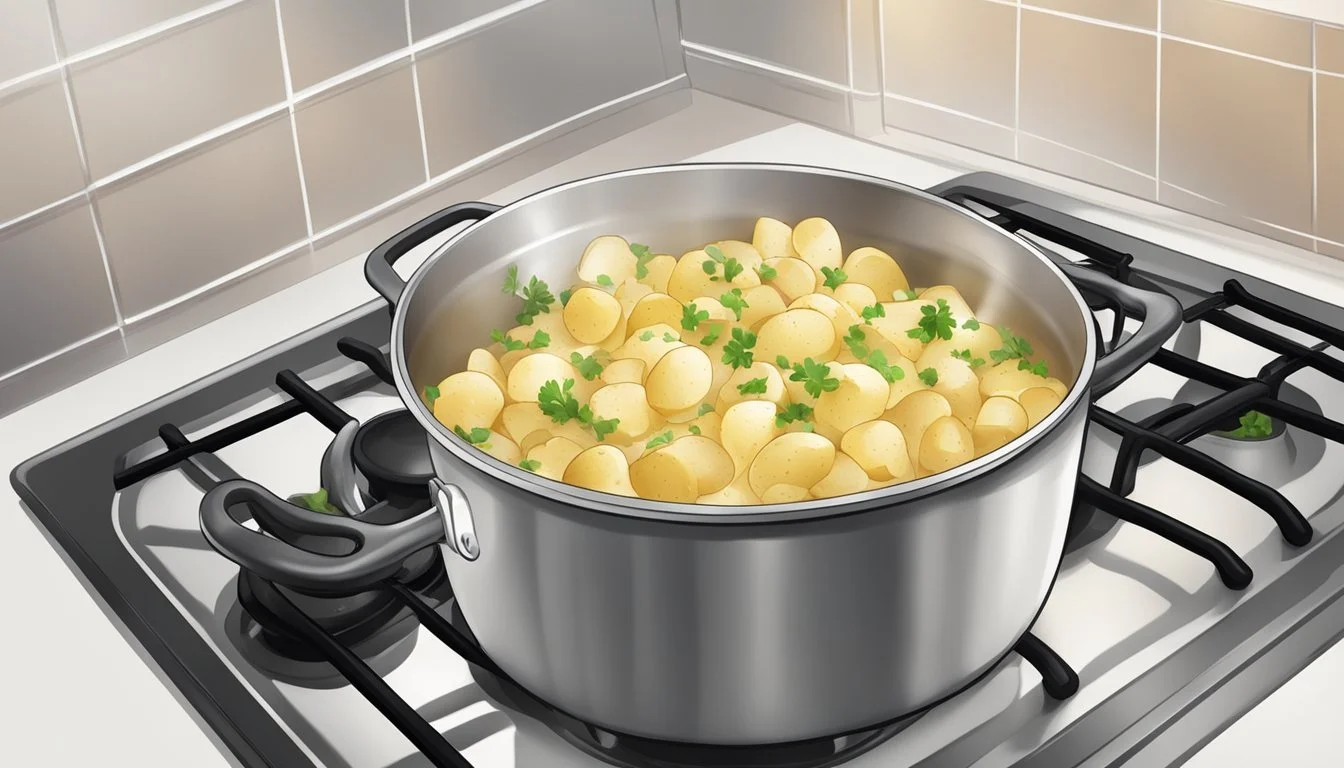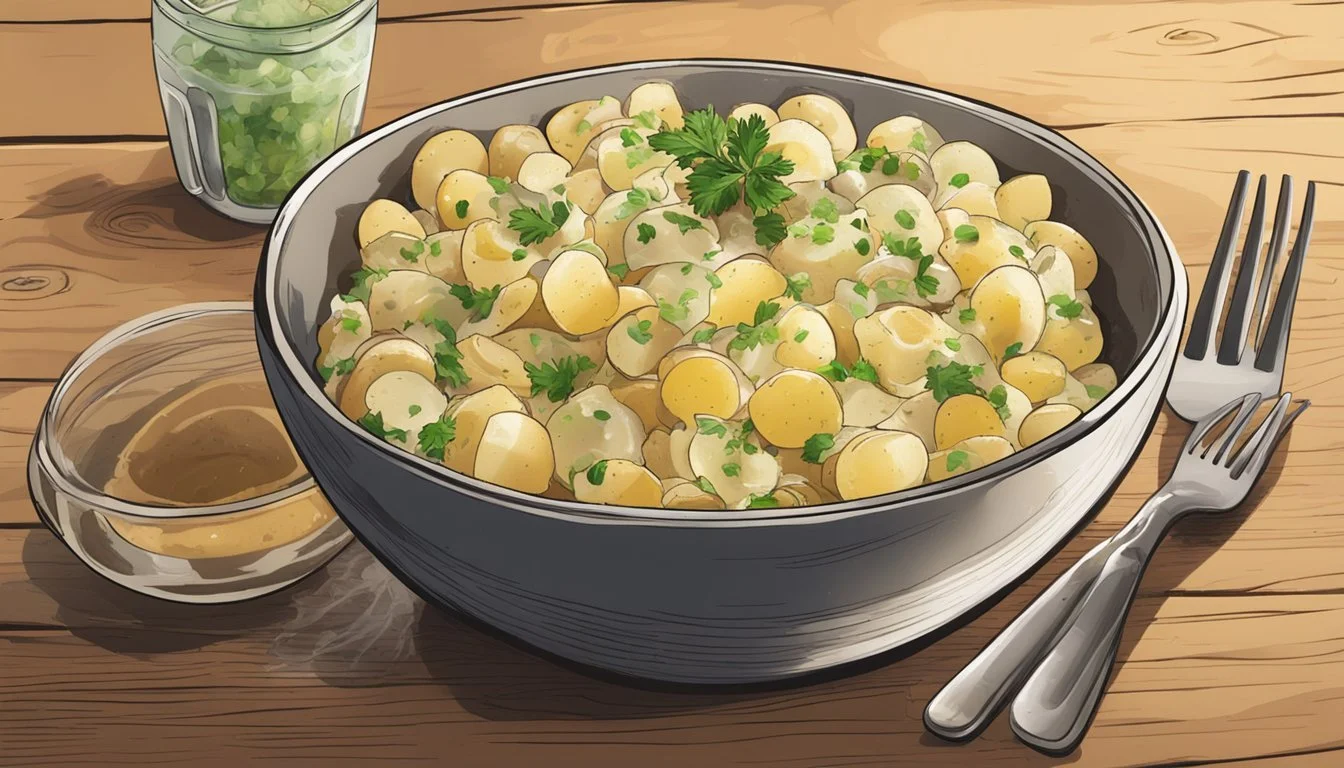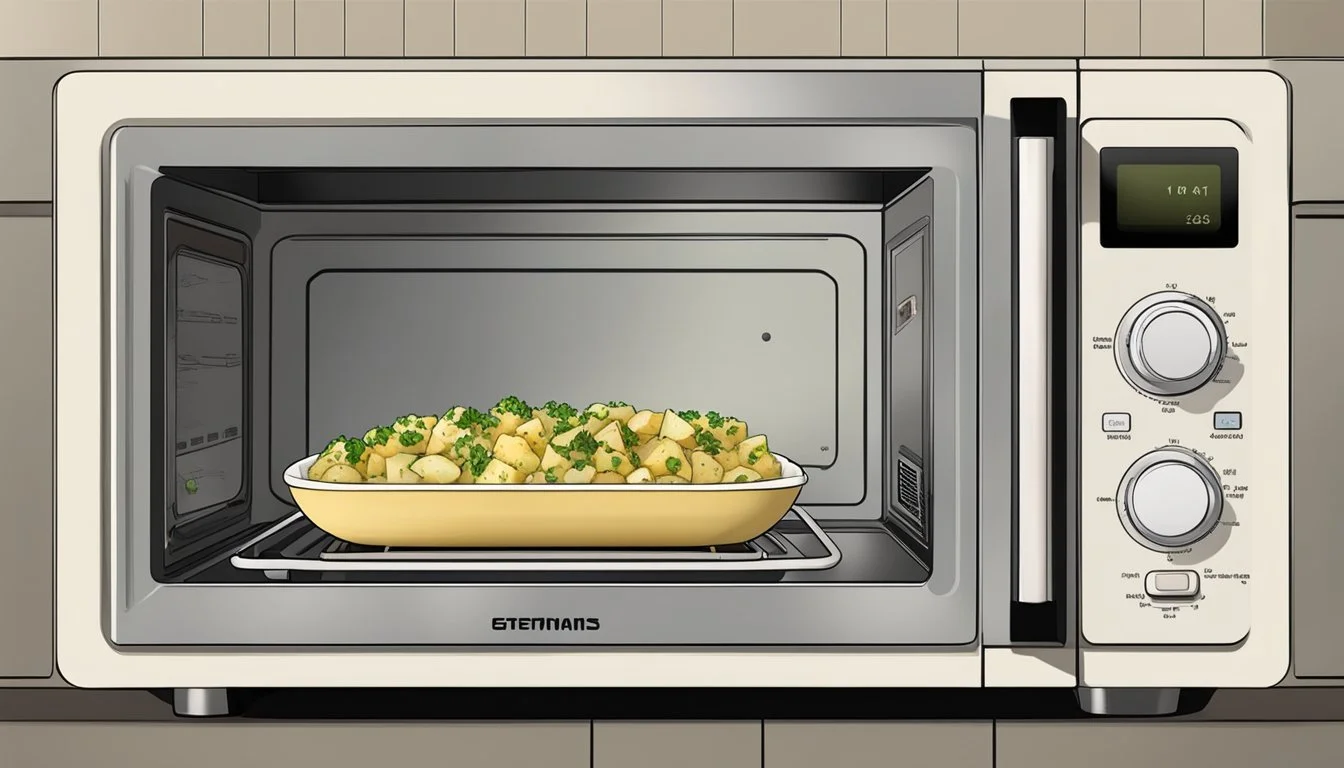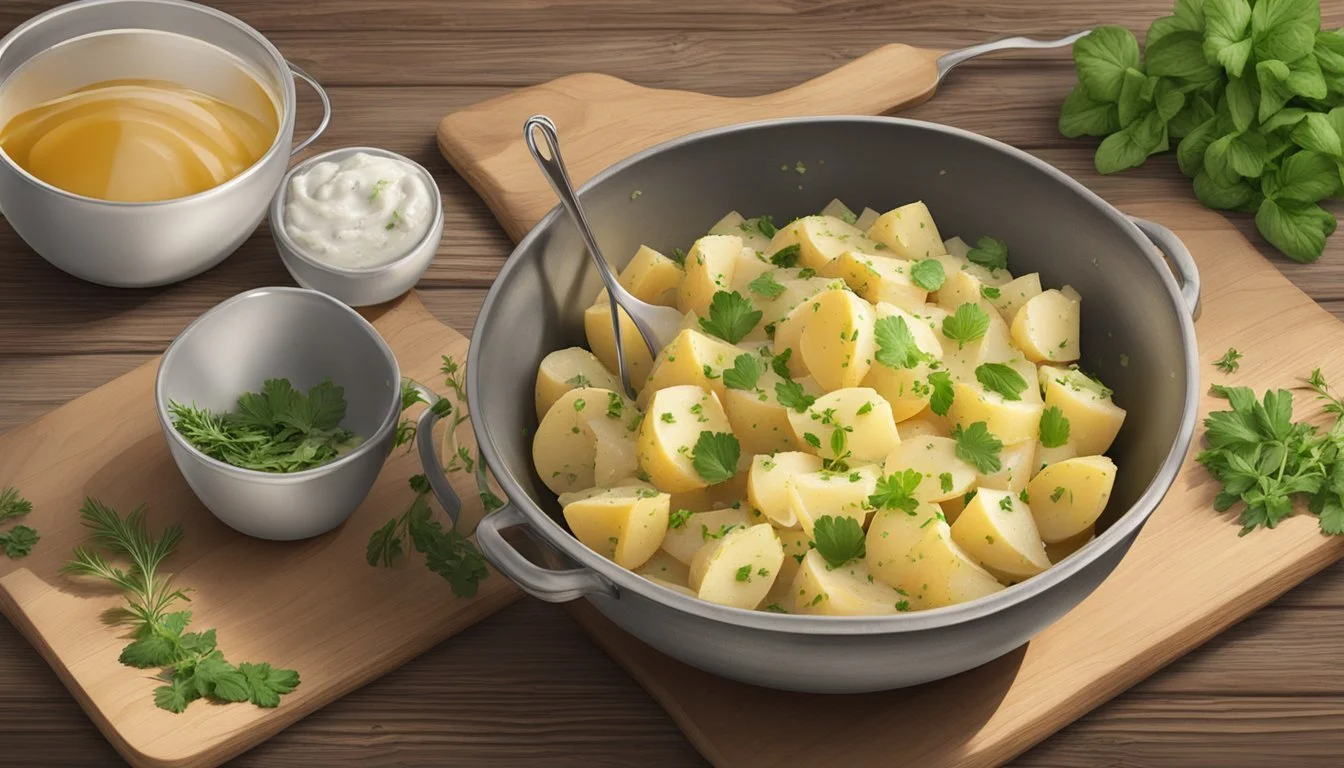Best Way to Reheat German Potato Salad While Preserving Its Zesty Taste
German potato salad is a popular dish known for its tangy flavor which is a hallmark of this savory side. The salad typically combines boiled potatoes (What wine goes well with potatoes?) with a distinctive dressing made from vinegar, mustard, and various herbs. Maintaining the integrity of this flavor profile when reheating is important for both taste and texture. The key is to warm the salad gently, so the potatoes stay firm and the dressing retains its zesty tang, rather than becoming oily or overly absorbed by the potatoes.
Reheating German potato salad correctly will ensure that it is just as enjoyable as when it was freshly made. One can opt for different approaches depending on the tools at hand and the quantity of the salad. A microwave may be used for quick reheating of small servings, being careful to stir the salad at short intervals to distribute heat evenly without overcooking. For larger amounts, using a stovetop method with a non-stick skillet can provide more control over the heating process, allowing the salad to regain its original warmth without altering the balance of flavors.
The best way to reheat German potato salad entails heating it just to the right temperature where it is pleasantly warm, yet the distinct tangy flavor of the dressing is preserved. This not only revives the potato salad but also rejuvenates its aromatic appeal, presenting it as if it were freshly prepared. Through careful heating, one can enjoy a perfectly warmed up dish that complements any main course just as well as the original serving.
Understanding German Potato Salad
German potato salad, known for its unique tangy flavor, is a traditional side dish that differs significantly from its American counterpart. It is served warm or at room temperature and incorporates distinctive ingredients and seasonings, presenting a fusion of rich textures and tastes.
Origins and Traditional Ingredients
German potato salad, or Kartoffelsalat, has its roots in German cuisine. The traditional recipe includes waxy potatoes such as red potatoes or Yukon golds, which hold their shape after cooking. It typically features a combination of vinegar, bacon, onions, mustard, and sometimes pickle, offering a tangy taste that is both hearty and robust.
Comparing German and Regular Potato Salad
In contrast with the common American potato salad, German potato salad does not rely on mayonnaise as a base. Instead, it is dressed with vinegar—often apple cider or white wine vinegar—and flavored with bacon, mustard, and onions. The absence of mayonnaise and addition of vinegar lend the German version a tangier and lighter profile.
Health and Nutrition Facts
German potato salad is generally lower in calories and fat than its mayonnaise-based counterparts, although the inclusion of bacon and oil-based dressing can still contribute to its calorie content. However, it can be considered a more nutritious option with its emphasis on vinegar and the inclusion of fresh onions and herbs.
Selection of Potatoes for the Salad
The choice of potato is critical for the perfect texture and flavor. Red potatoes and Yukon gold potatoes are preferred for their waxy texture, which holds up well during cooking and mixing. These potatoes absorb the dressing while maintaining their shape, contributing to the salad’s overall appeal.
Homemade Dressing versus Store-Bought
A homemade dressing for German potato salad heightens its authenticity and flavor. Traditional recipes often include a blend of vinegar, oil, mustard (preferably Dijon), and a touch of sweetness to balance the acidity. A store-bought dressing can be used in a pinch, but making it at home allows for more control over the flavor profile.
The Role of Fresh Ingredients and Herbs
Incorporating fresh parsley, chives, garlic, and other herbs into the salad is pivotal for enhancing its flavors. These fresh ingredients contribute a burst of freshness that complements the tangy vinegar dressing, elevating the sensory experience of the dish.
Preparation and Cooking Techniques
German potato salad is a classic dish known for its unique tangy flavor and hearty ingredients. This section will guide you through the essential steps of making this salad from scratch, cooking the potatoes to the right texture, preparing a signature tangy dressing, and deciding on the inclusion of bacon.
How to Make German Potato Salad from Scratch
To prepare German potato salad from the ground up, one must first gather the necessary ingredients which typically consist of potatoes, vinegar, mustard, onion, oil, sugar, salt, pepper, and often bacon. The method involves boiling potatoes, creating the dressing, and combining these with the cooked bacon and other ingredients.
Cooking the Perfect Potatoes
For the salad, select firm, waxy potatoes such as Yukon Golds. Begin by:
Boiling the potatoes in a large pot of salted water until they are just tender. This usually takes about 15-20 minutes depending on the size of the potatoes.
Drain the potatoes and let them cool slightly before cutting them into slices or chunks. The key is maintaining a firm texture that doesn't fall apart when mixed with the dressing.
Creating the Signature Tangy Dressing
The dressing imparts much of the salad’s flavor and requires a careful balance of ingredients. To achieve the signature tangy taste, whisk together:
Vinegar and mustard, which form the acidic base of the dressing.
Oil, to emulsify and bring the dressing together.
Sugar, salt, and pepper to taste.
Adjust the quantities to ensure the dressing is flavorful and tangy, complementing the potatoes.
Bacon: To Include or Not
Bacon adds a robust depth to the salad, but its inclusion is based on personal preference. For those who choose to include it:
Cook the bacon strips until they are crispy.
Crumble or chop the bacon and mix it into the salad to add a smoky flavor and a pleasant crunch.
Those abstaining from bacon can replace it with smoked salt or a vegetarian alternative to mimic the smoky taste.
Best Reheating Practices
To maintain the signature tangy flavor and pleasant texture of German potato salad, the method of reheating is critical. Here, we explore the best reheating practices that preserve the quality of this traditional dish.
Understanding the Importance of Reheating
Reheating German potato salad requires a delicate balance to preserve its texture and flavors. Proper reheating revitalizes the tangy taste without turning the potatoes mushy.
Reheating Methods Compared
The main reheating methods include the microwave, oven, and stovetop. Each method has its own benefits:
Microwave: Quick and convenient for small portions.
Oven: Provides even heating and can rejuvenate flavors well.
Skillet: Offers a unique opportunity to add a slight crunch to the texture.
Microwave Reheating Tips
When using a microwave, reheat the German potato salad in one-minute intervals, stirring between each to prevent cold spots. Utilizing a microwave-safe dish:
Heat for 1 minute.
Stir and check temperature.
Repeat as necessary until evenly warm.
Oven-Baked for Optimal Taste
An oven can restore the leftovers effectively. Place the salad in a baking dish and cover to prevent moisture loss. Use these steps:
Preheat oven to 350°F.
Reheat for 10-15 minutes, stirring occasionally.
Skillet Warming for a Crunchy Texture
For a slight crunchy texture, a skillet on the stovetop offers excellent heat control. Heat the skillet over medium heat, add the salad, and stir gently.
Preventing Moisture Loss During Reheating
To prevent moisture loss:
In a microwave: Cover the dish with a microwave-safe lid.
In an oven: Use an airtight container or cover the baking dish with foil.
On the stovetop: Stir slowly and consistently to distribute heat without drying out the potatoes.
Serving and Pairing Suggestions
When presenting German potato salad, the temperature, accompaniments, and occasion play significant roles in highlighting its unique tangy flavor. Each element from garnish to pairing has the potential to elevate this dish to new heights.
Ideal Serving Temperature for German Potato Salad
The best way to serve German potato salad is either hot or at room temperature, which allows the vinegar, mustard, and bacon flavors to shine through. Serving it cold may mute its distinct tanginess.
Pairing with Proteins and Other Side Dishes
Protein Pairings:
Chicken: A light complement that balances the salad’s robustness.
Sausages: A classic German pairing.
Pork: Matches the salad's hearty flavor profile.
Grilled Meats: Adds a smoky layer that enhances the potato salad.
Side Dish Pairings:
Rye Bread: Absorbs the dressing and complements the texture.
Sauerkraut: Provides a tangy counterpoint to the richness.
Mixed Greens: Adds a refreshing contrast to the salad’s savoriness.
Choosing the Right Event for Serving
German potato salad is versatile and fits a variety of events:
Picnics: Its robustness stands up to outdoor settings.
Potlucks: A popular crowd-pleaser, easy to share.
Gatherings: Pairs well with a range of dishes usually found at communal meals.
Garnishing and Final Touches
Garnish German potato salad with fresh herbs like chives or parsley right before serving to add a fresh, bright finish and vibrant presentation.
Alternative Serving Suggestion
For an alternative to the traditional warm serve, consider offering the German potato salad chilled during summer events. This can provide a refreshing option for picnics and BBQs, although the tangy flavors may be less pronounced when cold.
Additional Tips for Enhancing Flavor
To enhance the tangy flavor of German potato salad, consider these tips:
Freshness: Use fresh, high-quality ingredients for the best flavor.
Spice: Add a pinch of extra mustard or a splash of vinegar if the salad tastes too bland after reheating.
Storing and Preservation for Longevity
Effectively storing and preserving German potato salad not only extends its shelf life but also maintains the distinct tangy flavor profile. It is essential to store it correctly to avoid bacterial growth and food poisoning.
Storing Leftovers in the Refrigerator
Leftover German potato salad should be kept in the refrigerator within two hours of serving to prevent bacterial growth. It should be stored in an airtight container to preserve the flavors and textures and to keep out any unwanted odors.
Temperature: Keep at or below 40°F (4°C).
Container: Airtight, shallow containers are ideal.
Shelf life: 3-5 days.
Can You Freeze German Potato Salad?
Freezing German potato salad is not recommended as it can significantly alter the texture of the potatoes and the emulsion of the dressing.
Texture changes: Potatoes can become watery and grainy.
Dressing separation: The vinegar-based dressing may separate and not re-emulsify well.
How Long Does German Potato Salad Last?
When refrigerated properly, German potato salad will last for 3 to 5 days. The vinegar in the dressing acts as a natural preservative, but despite this, it should not be left out at room temperature for extended periods.
Refrigerator: 3-5 days for best quality.
Room temperature: Not recommended to be left out for more than 2 hours.
Tips for Preventing Food Poisoning
To ensure safety, one should avoid cross-contamination, keep the salad cold until serving, and discard any leftovers that have been left out for more than 2 hours.
Avoid cross-contamination: Use clean utensils.
Keep it cold: Store promptly after serving.
Separate Storage for Ingredients
If possible, store ingredients separately to maximize their shelf life and preserve their individual flavors and textures. Dressing can be stored in a separate container and mixed with the potatoes before serving.
Dressing: Refrigerate in a separate airtight container.
Ingredients: Keep ingredients like cooked potatoes and hard-boiled eggs refrigerated separately.
Frequently Asked Questions (FAQs)
In this section, you'll find answers to common inquiries regarding the preparation, serving, and storage of German potato salad, as well as tips for customizing the dressing and exploring variations of this classic dish.
Is German Potato Salad Served Hot or Cold?
German potato salad is traditionally served warm and is known for its tangy vinegar-based dressing. While it's common to enjoy it hot, some people prefer it cold, especially when prepared for events or served as a leftover.
Can I Prepare German Potato Salad in Advance?
Yes, German potato salad can be prepared in advance. It's often recommended to make it a day ahead, as this allows the flavors to meld overnight. When storing, cover and refrigerate the salad to maintain freshness.
What Are the Best Practices for Leftover Storage?
For leftovers, it's crucial to store the German potato salad in an airtight container within the refrigerator. Proper storage will help maintain its quality and safety for consumption. Leftovers typically keep well for 3-4 days.
Can I Use Different Types of Vinegar in the Dressing?
Certainly. While apple cider vinegar is commonly used in German potato salad for its mellow tang, alternatives like white or cider vinegar are also suitable options. The choice of vinegar can affect the final taste profile of the dressing.
Are There Variations to the Classic German Potato Salad?
Variations to the classic German potato salad do exist. Some recipes may incorporate ingredients like bacon, green onions, or mustard. The traditional recipe calls for a warm, vinegar-based dressing, but variations may adjust ingredients to cater to personal preferences or dietary requirements.








